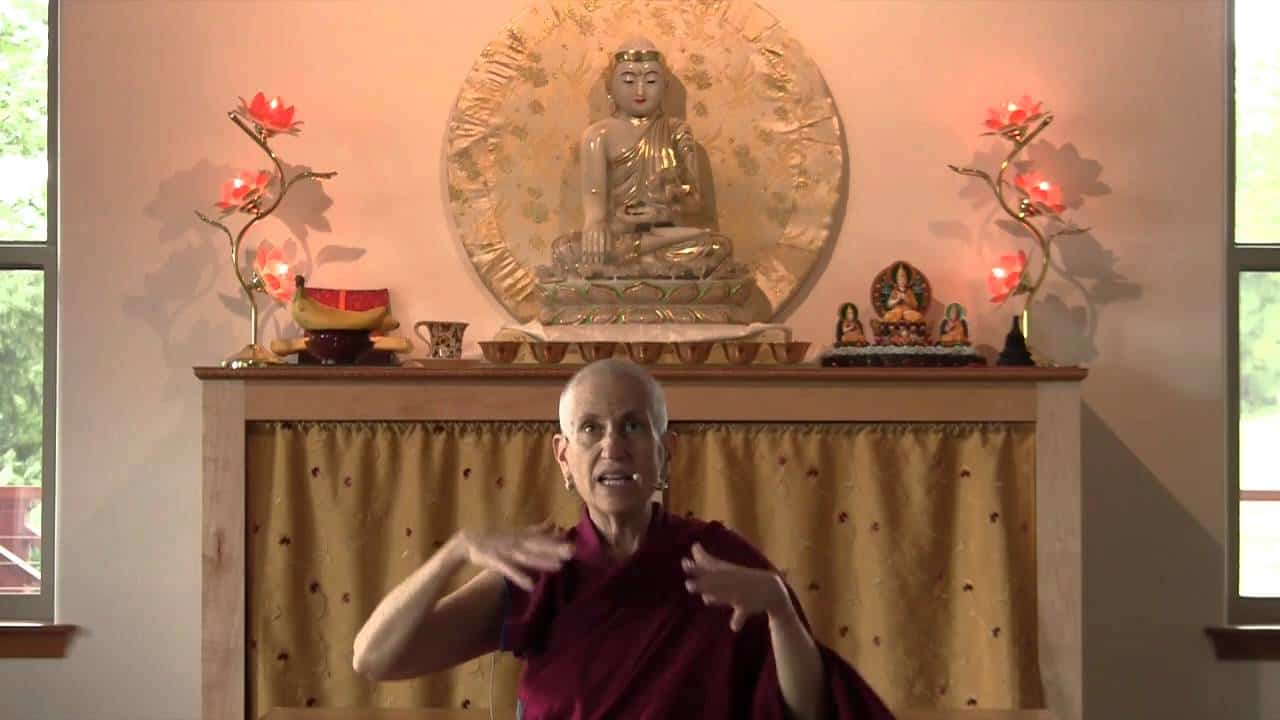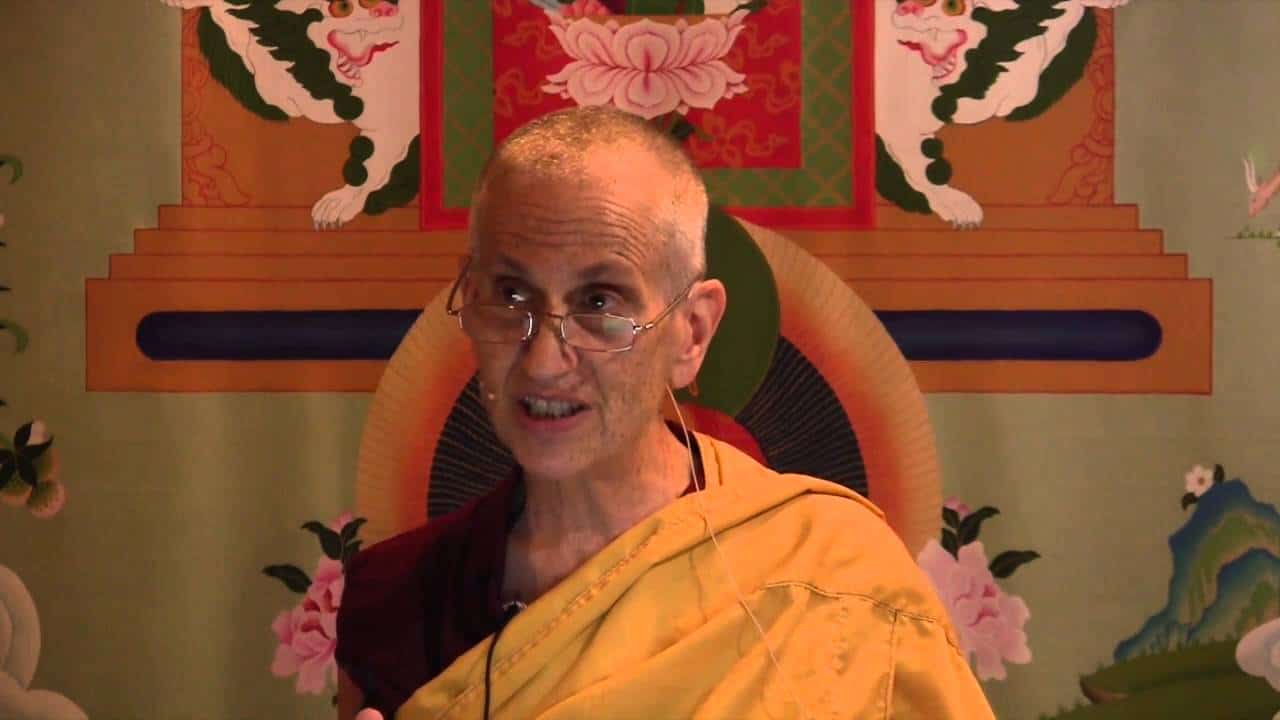Antidotes to attachment
Part of a series of teachings on a set of verses from the text Wisdom of the Kadam Masters.
- Meditating on impermanence
- How it’s the feeling that we’re attached to, which we attribute to an object (or person)
- Visualization practice to counteract attachment
- Working with attachment to praise and reputation
Wisdom of the Kadam Masters: Antidotes to attachment (download)
Antidotes to attachment.
Let’s skip that one. Let’s go to “antidotes to other people’s anger.” [laughter] Not to our own anger, their anger.
My attachments, we don’t want to apply antidotes.
Well, like I said before, when you really see how much attachment causes problems in your life then you want to.
Meditating on impermanence is the general antidote. Like I said before, we’re actually attached to the feeling from the object, and then we impute that on the object. But it’s actually the feeling that we’re attached to, that we want more of.
Which is why visualization practice works so well, because some of those feelings of joy and bliss and acceptance and being understood, and so on, you can replicate those in your visualizations, in your meditation practice without needing an outside object to get attached to.
This, actually, is a very good antidote, like when you’re lonely. When I got lonely you know what I used to do is imagine Chenrezig with all 1,000 arms hugging me. That did the trick. I didn’t need anybody else to hug me. Whenever I needed a hug Chenrezig did it. When you’re doing the Guru Yoga practice and you imagine the Guru Buddha or Guru Chenrezig, or whatever, and you think of their qualities, you tell them what’s on your mind, and when you’re asking for blessings, when you’re asking for inspiration, basically what you’ve done is you’ve confessed everything that needs to be confessed, and you think of the things you don’t like about yourself, and the things that you want to cultivate in yourself, and so you’re putting all of that out there, that’s what’s really in your heart, and he’s listening to it, and then when you’re saying “please inspire me” that’s how Chenrezig shows that he’s really understood you and really heard you.
It’s interesting, because we always want to feel like we’re heard when we’re mad, don’t we? Or when we’re sad. Yes, okay, we can tell all of that to Chenrezig, too, but that’s going to be a different way of telling it than if we tell it to another person. With a person, I don’t know about you, but I’m kind of looking for a little, “Oh, poor girl, they treated you like that, that’s so bad, those people, they shouldn’t treat you like that.” you know, a little bit of comfort. Although they’re helping me with my anger, they’re also subtly telling me that I was right all along, and those people are nasty. But when you do that with Chenrezig, when you say the same thing, “I’m really mad at so and so,” you can’t sit there and continue to blame somebody else in Chenrezig’s or the Buddha’s presence. It just doesn’t work. Or when you’re dissatisfied, you’re not getting your object of attachment, “i want this, I want this.. I’m not getting this…. I’m so attached to it….,” it’s just like after a while you can’t keep saying that to the Buddha. Because if you’re really imagining, in your practice, having this conversation with the Buddha, you think the Buddha’s going to go, “Oh, well I’ll send you your object of attachment, that’s just what you need to make you happy.” Forget it. The Buddha’s not going to do that. The Buddha’s going to say, “You want to be happy? I’ll help you let go of the attachment.” Because the attachment is the problem, not the object.
Using your Guru Yoga practice, your visualization, is one good way to counteract both the attachment, and especially the anger and jealousy.
With attachment especially, thinking of the impermanence of the feeling and the impermanence of the object itself. Of course, yes, that mint chocolate chip ice cream is impermanent, it’s going to be gone in 30 secondsI want it. Our understanding of impermanence sometimes doesn’t work. It isn’t strong enough. We have to really think. That’s why I think thinking of the disadvantages of the attachment often works really well.
Another thing that I find is very effective with attachment—where thinking of impermanence doesn’t work so well—is when I’m attached to praise and reputation…. Because if I think that’s impermanent, yes, it’s impermanent but I still want more, and I’ll get more later. Okay, I’ve had enough now, but I’ll get more later. But when I do this other one I find it works very well. Of course, thinking about impermanence may work well for you, so don’t listen to me in that regard. See what works well for you. But sometimes what I do is I imagine getting whatever it is I’m craving, and then I say, “Now what?” There I am, fantastic person, with this fantastic person, lying on the beach, they’re praising me up, down, and across, and everything’s just wonderful, and they love me to bits, and they’re never going to leave me…. And now what? Or, “I finally got my ideal job, and without much effort I went from the bottom of the pile to the top of the pile, and I got the position I really wanted, and everybody knows how skilled I am, and I’m able to do this wonderful work, and really contribute, and I get lots of praise from society….. And now what?” Now am I going to really feel good about myself? I find this one is just like cold water on my attachment to praise and reputation. Yes, you got all of that, so what? So what? What does it do for you? Zero.
If I want all that praise and love and appreciation, having it come from outside doesn’t really counteract the main problem, which is my lack of self-acceptance. And until I deal with my lack of self-acceptance, all of that stuff is like a bandaid.
You know how it is, you get praise and your reputation, and one part of you is [playing it up] and then the other part is, “I hope they don’t find out what I’m really like.” [laughter] Or, “Uh oh, somebody’s maybe going to be better than me later on, then I’m going to feel terrible.”
I think, with the praise and reputation, think of what comes after you get it. Like, that person who loved you to bits falls out of love. The person who praised you starts picking faults. Because that’s the way it is, isn’t it? Nobody constantly praises us. So you think of what comes after. Then you really see, “Oh, the more I’m attached the more it’s one big setup for pain. One big setup. I find that works really well, especially for praise and attachment, wanting “tell me how wonderful I am.”
That’s a good antidote. Try working with that. And then also just the impermanence. Sit down there, especially if it’s with a physical object. Take your chocolate, or whatever it is that you’re attached to, your greasy fried food, and just watch it bite by bite, and where’s the pleasure in this? And just watch. You can imagine the sensation of chewing whatever it is, and what it’s like. Just do it really slowly. Or take the actual thing that you’re attached to and eat it very, very slowly. It’s amazing when you do that, at least when I do it, I realize that I hardly taste my food. Because usually the attachment is so much to wanting it, but once I’m actually eating it I’m hardly paying attention to the taste. I’m paying attention to something else because sitting there and having to pay attention to the taste is quite boring. It’s so interesting how that works with food, don’t you think? If you had to sit there and eat everything very slowly it’s so boring. But the attachment to getting it, is this scintillated pleasure. But when you have it it’s not really that good. And then of course you’re so busy thinking, “It’s going to end, and how can I go back and get seconds before everybody else eats it?” The mind’s hardly relaxed.
Try some of that stuff and see if it works.
Venerable Thubten Chodron
Venerable Chodron emphasizes the practical application of Buddha’s teachings in our daily lives and is especially skilled at explaining them in ways easily understood and practiced by Westerners. She is well known for her warm, humorous, and lucid teachings. She was ordained as a Buddhist nun in 1977 by Kyabje Ling Rinpoche in Dharamsala, India, and in 1986 she received bhikshuni (full) ordination in Taiwan. Read her full bio.


